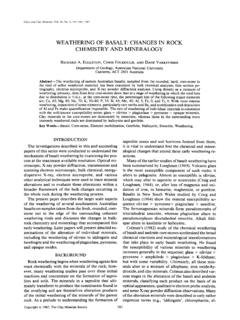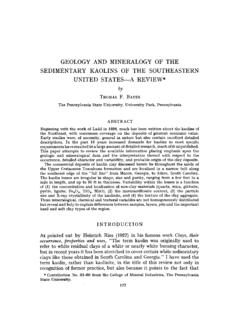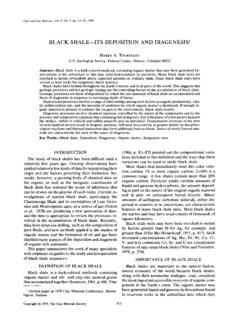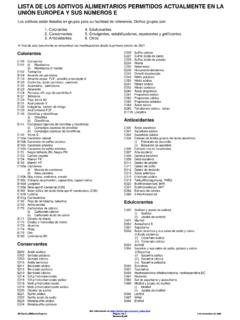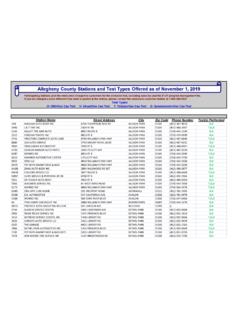Transcription of FORMATION MECHANISM OF ALUMINUM …
1 Clays and Clay Minerals, Vol. 41, No. 5, 590-597, 1993. FORMATION MECHANISM OF ALUMINUM hydroxide polymorphs A. VIOLANTE l AND P. M. HUANG 2 Dipartimento di Scienze Chimico-Agrarie, Universit~ di Napoli "Federico II" 80055 Portici, Napoli, Italy 2 Department of Soil Science, University of Saskatchewan, Saskatoon Saskatchewan, Canada S7N 0W0 AImtraet--Substantial studies have been carried out to investigate the MECHANISM of the FORMATION of AI(OH)3 polymorphs . The influence of the nature of Al precipitation products on the FORMATION of Al(OH)3 polymorphs still remains obscure. In this study, X-ray diffraction, infrared and thermal analyses, and electron microscopic observations of the Al precipitates formed at the initial pH and at a citric acid/ A1 molar ratio of and aged for 3 hr to 60 days revealed that the transformation from the initially formed noncrystalline materials to pseudoboehmite occurred through the FORMATION of intermediate materials with various degrees of ordering and sizes of particles that apparently had a wide range of solubility.
2 By increasing the pH of the suspension of precipitation products of A1 to after 3 hr and 3, 11, 31, and 60 days or longer, the crystalline precipitation products were hayerite, nordstrandite and bayerite, nordstrandite and pseudoboehmite, pseudoboehmite and gibbsite, and pseudoboehmite, re- spectively. This work shows evidence that, as the nature of the starting Al precipitates changed, the rate of their dissolution apparently changed, and various AI(OH)3 polymorphs consequently formed. Therefore, the data substantiate the hypothesis that the MECHANISM of the FORMATION of an AI(OH) 3 polymorph is determined by the rate of its nucleation, which is, in turn, influenced by the rate of dissolution of the noncrystalline or poorly ordered Al-oxides initially formed. Key Words--Al(OH)3 polymorphs , Bayerite, Gibbsite, Noncrystalline materials, Nordstrandite, Pseu- doboehmite. INTRODUCTION ALUMINUM hydroxides (gibbsite, nordstrandite, and bayerite) and oxyhydroxides (boehmite) are present in nature.
3 Gibbsite is the most common of the three AI(OH)3 polymorphs in soils and bauxites. Bayerite is rare in natural environments, but is easily synthesized in the laboratory. Occurrence ofnordstrandite in some alkaline soils and bauxites (mainly in Jamaica) has been documented (Violante and Jackson, 1979; Vio- lante et al., 1982; Hsu, 1989). Boehmite frequently occurs with gibbsite and/or nordstrandite in bauxites. In many bauxite deposits boehmite consists of sub- microscopic particles, which are similar to the pseudoboehmite ~ prepared in the laboratory at low temperatures and pressures (Souza Santos et aL, 1953; Calvet et al., 1953; Papee et aL, 1958; Hsu, 1967; Wefer and Bell, 1972; Tettenhorst and Hofmann, 1980; Vio- lante and Huang, 1984, 1985). Furthermore, gibbsite and "amorphous boehmite-like alumina" have been found in many tropical soils in Australia, South Africa, Brazil, and Puerto Rico (de Villiers, 1969).
4 For many years, most researchers have claimed that, at ambient temperature and pressure, pseudoboehmite was only a transitional phase between the initially formed noncrystalline material and the final AI(OH)3 ' Boehmite formed at room temperature and one atmo- sphere pressure is a poorly crystalline, highly defective and/ or fine size AI-oxyhydroxide, usually called pseudoboehmite. Copyright @ 1993, The Clay Minerals Society polymorphs (Souza Santos et aL, 1953; Calvet et al., 1953; Aldcroft et al., 1969; Wefer and Bell, 1972; Yol- das, 1973; Serna et aL, 1977). Recently it has been ascertained that at certain pHs (from to ) and critical ranges of ligand/A1 molar ratios (R), inorganic and non-humified organic ligands (Violante and Vio- lante, 1980; Violante and Jackson, 1979, 1981; Vio- lante and Huang, 1984, 1985; Huang and Violante, 1986) as well as fulvic (Kodama and Schnitzer, 1980) and humic acid (Singer and Huang, 1993) facilitate at ambient temperature and pressure the FORMATION of pseudoboehmite.
5 In the presence of citric acid (R = ), pseudoboehmite forms at an initial pH of and does not change into AI(OH)3 polymorphs even after prolonged aging (Violante and Huang, 1985; Vio- lante et aL, 1993). Substantial studies have been conducted to inves- tigate the MECHANISM of the FORMATION of Al hydroxide polymorphs (Hsu, 1989). The significance of the nature of a series of precipitation products of Al in the for- mation of AI(OH)3 polymorphs still remains obscure. The objective of this study was to evaluate the influence of the nature of starting A1 precipitation products formed in the presence of citric acid on the FORMATION of AI(OH)3 polymorphs upon aging after the pH of the system was adjusted to MATERIALS AND METHODS Al precipitation products were obtained by the ad- dition with stirring of M NaOH at ~2 ml/min to 590 Vol. 41, No. 5, 1993 FORMATION of ALUMINUM hydroxide polymorphs 591 o Aging period (day) 6i55A a i b :3 ) I c 2~ 24 2'2 ~ 18 16 1~, 12 29 CuKa Radiation 1 I 10 8 e Figure 1.
6 X-ray diffractograms (oriented aggregate speci- mens) of A1 precipitation products formed at citric acid/A1 molar ratio of and at pH after a) l, b) 3, c) 6, d) 19, and e) 60 days of aging. During the aging period of 60 days to 8 months, the peak of pseudoboehmite remained practi- cally unchanged (not shown). a 1 liter solution containing AICI3 ( M) and citric acid ( x 10 -3 M; citric acid/Al molar ratio of ). The concentration of total Al in the final suspension (3 liter) was x 10 2 M, and its final pH was adjusted to (OH/A1 molar ratio was ). The suspension was aged in a polyethylene bottle, and its pH was re- corded during aging by a Metrohm E436 potentio- graph. Aliquots of the suspension were collected after 3 hr; 1, 3, 6, 1 l, 19, 31, 43, and 60 days; and 8 months. The precipitate in the suspension was collected by ultrafil- tration and washed with deionized distilled water through a Millipore filter of #m pore size.
7 Some of the precipitate collected was air-dried and lightly ground to pass through a 100-mesh sieve. Air-dried samples (< 100 mesh) were mounted in a holder to obtain random orientation of particles. Ori- ented specimens for X-ray powder diffraction (XRD) were obtained by drying the ultrafiltered and washed precipitate of the aged samples on glass slides. Both were analyzed with a Philips X-ray diffractometer, us- ing Ni-filtered CuKot radiation generated at 35 Kv and 16 mA. Infrared spectra of the precipitation products of A1 were obtained from KBr discs containing air- dried samples (2 mg/100 g KBr). The spectra were recorded in the 400-4000 cm -~ range on a Perkin- Elmer 567 IR spectrophotometer. For transmission electron microscopic (TEM) examination, one drop of a sample suspension was deposited on carbon-coated Formvar film on a Cu grid. TEM electron micrographs were taken with a Philips EM 400.
8 Differential thermal analyses (DTA) of selected samples were carried out by using a Rigaku Differential Analyzer. About 200 mg of air-dried samples were heated in a Rigaku fur- nace that was programmed to raise the temperature from 25* to 1000*C at a rate of 10~ The chemical composition, point of zero charge (PZC), specific surface area, and HzO/Alz03 molar ra- tio of Al precipitation products during the aging process were determined by the methods described elsewhere (Violante and Huang, 1984). The pH of 350 ml of the suspension, collected during the aging period ranging from 3 hr to 60 days, was adjusted to by adding M NaOH using an au- tomatic titrator, Metrohm Herisau E 436. The systems were adjusted at this pH in order to accelerate the FORMATION of AI(OH)3 polymorphs so as to facilitate the study on the factors that promote the FORMATION of Al-hydroxides and oxyhydroxides. After the pH ad- justments, all these suspensions were aged for another 8 months in polyethylene bottles and then analyzed by X-ray diffraction and electron microscopy.
9 RESULTS Effect of aging on the nature of Al precipitation product Figure 1 shows the XRD patterns of the A1 precip- itation products formed at pH during the aging process. Initially, a noncrystalline material formed (Figure la), but pseudoboehmite began to appear a few days after the sample preparation (Figure lb). The 020 reflection increased in intensity upon aging (Figures 1 b-- 1 e), and a variation in its peak breadth and position from the lower (Figure lb) to higher 20 values (Figure le) was observed. The variation in the peak breadth and position of the 020 reflection during the aging pro- cess seems to be due to an increase in size and/or in crystallinity of the A1 precipitation products (Tetten- horst and Hofmann, 1980; Violante and Huang, 1984, 592 Violante and Huang Clays and Clay Minerals Am ~r~ay) J ~0 b 140 o00 TEMF~RATUFE, ~ Figure 2. Differential thermal analysis patterns of AI pre- cipitation products formed at citric acid/Al molar ratio of and at pH after a) l, b) 6, and c) 60 days of aging.
10 1985; Violante et al., 1989, 1993) as well as to a partial removal of H20 molecules situated between the ele- mental layers (Papee et al., 1958; Hsu, 1967, 1989; Yoldas, 1973; Tettenhorst and Hofmann, 1980). The infrared analysis (not shown) strengthens the findings of XRD analysis. The A1 precipitation prod- ucts collected after 3 hr or 1-2 days did not show bands of boehmite. After 11 days broad bands characteristic of pseudoboehmite at about 3300, 3100, 1080, 760 and 490 cm -~ (Wefer and Bell, 1972; Violante and Huang, 1984, 1985; Hsu, 1989) appeared quite well resolved. Some of these bands (at ~3100, 1080 and 490 cm-1) increased in intensity during the aging pro- cess. DTA patterns show a continuous gradation of bond- ing energy for the water (Figure 2). The endotherm at 140"--148"C was attributed to sorbed water. The very broad endotherrns at 260"--300~ of the samples aged 1 and 6 days (Figures 2a and 2b) indicate the presence of strongly bound water molecules.



